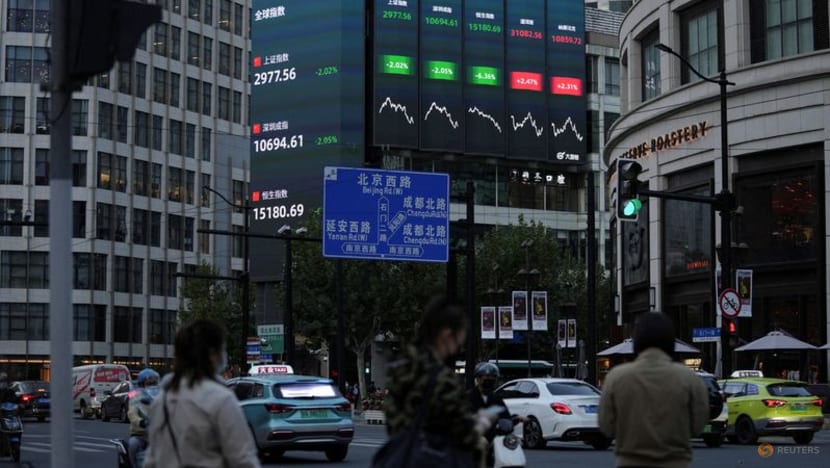Commentary: Is China’s era of miracle growth over?
China’s economic growth has declined in the last decade, hitting new lows in the post-COVID era. Market-oriented reforms are necessary in reversing this trend, says former economics professor Chen Kang.

A view of a giant display of stock indexes, following the COVID-19 outbreak, in Shanghai, China on Oct 24, 2022. (Photo: Reuters/Aly Song)

This audio is generated by an AI tool.
SINGAPORE: China had maintained a high rate of economic growth for four decades since it began reforms in the late 1970s. By the end of 2019, its gross domestic product (GDP) had grown to 39 times what it was in 1978.
In the last decade, however, the rates of growth have been trending downward, from double digits in the 2000s, to 6 to 7 per cent in the 2010s, and sliding further down to 5 per cent in the post-COVID period.
Official data released on Wednesday (Jan 17) showed that China's economy grew 5.2 per cent in 2023 from the previous year.
Is China’s miraculous growth era over? What is China's economic outlook for 2024 and beyond?
To answer these questions, we need to understand what China’s key challenges are and where its reform process is heading.
MARKET SOCIALISM, HUNGARIAN STYLE
When China’s reformist leaders introduced market forces into the country in the 1980s, they learnt mainly from the “market socialism” experimented by Hungary in the 1970s and 1980s.
Under such a system, the government retains control over the key sectors which are considered as lifelines of the economy, believing that this is the basic guarantee for social stability. China’s economy therefore inherits the following three important characteristics of Hungarian market socialism.
The first characteristic is investment hunger. This describes a widespread phenomenon of local governments and state-owned enterprises who actively seek and engage in investment projects that accrue performance appraisal but do not necessarily generate acceptable economic returns and social benefits.
Second, local governments enjoy soft budget constraints. They have easy access to extrabudgetary financial resources, which are essential for them to fund investment projects and accommodate investment hunger.
Although the central government has strengthened its control over local government debts in recent years, soft budget constraints continue since ensuring economic growth remains to be one of the key performance indicators for local governments.
Third, China has a simulated financial market - key financial activities are orchestrated by the government. China’s central and local governments not only own and control most financial institutions, but they also possess the power of appointment and removal of executives.
The simulated financial market is essential to reinforce soft budget constraints and political objectives, so dominant players are not motivated by profit. Credit risks and counterparty risks are difficult to assess because they are strongly influenced by government decisions.
When risks cannot be appropriately assessed, it is difficult for financial products to be reasonably priced.
Furthermore, the heavy control of the government also means that the private sector has very limited access to formal financial resources and must rely mainly on informal channels which increase borrowing costs and uncertainties.
In the 1980s and 1990s, China was able to remove key institutional barriers to establish the goods and services market and the labour market, thereby releasing pent up energy to allow for rapid economic growth over the last 40 years.
China’s economy has also successfully integrated with the global economy under favourable international conditions, especially after its World Trade Organization accession in 2001.
However, China’s economy still has strong Hungarian characteristics, and there is no significant progress in developing the financial market, which is the most essential mechanism in allocating resources productively.
SAME PROBLEMS, DIFFERENT SOLUTIONS
Tight government control over resource allocation has created huge inefficiency because many entry or exit decisions of firms have become non-market decisions. It has led to rampant corruption, widening income inequality, environmental degradation and escalating government debt.
Observers from the left believe that China’s problems today, especially income inequality and corruption, are caused by private ownership and capitalist elements brought in by market-oriented reforms.
Blogger Wu Xiaoping opined in 2018 that it is time for China’s private sector to gradually exit as it has accomplished the task of helping the public sector grow the economy. His statements went viral on the Internet and created high levels of anxiety.
Liberals, on the other hand, think that the problems China is facing are mainly due to half-baked reforms which, not trusting the market, rely too much on government control and intervention.
They believe that it has come to a stage where political reforms cannot be avoided or delayed further, and that establishing the rule of law, limiting the power of the state, and redefining the role of the government in resource allocation are necessary in pushing market-oriented reforms.
A DECISIVE SHIFT
Economic growth as a means to boost the party’s legitimacy has essentially been exhausted in recent years. Soon after assuming power in 2013, China’s new leadership began to rely on socialist values and ideology to preserve its political legitimacy, reviving Mao-style political campaigns to ensure obedience among government officials.
These changes have triggered unorganised collective action among government officials who are motivated not only by top-down directives but also their personal interests and preferences. Changes in the political climate unleash massive government interventions that destroy the market’s vitality, as attested by developments in the private sector in recent years.
Private investment once comprised more than 60 per cent of total investment in China and was concentrated in the manufacturing and real estate sectors. But its growth rate dropped from 23.1 per cent in 2013 to 4.7 per cent in 2019, and it shrunk by 0.5 per cent in the first 11 months of 2023.
China’s problem is therefore fundamental and cannot be solved by stimulating the property market. To revitalise its economy, China needs to let the market play a decisive role in allocating resources, which was the policy direction announced in 2013.
Beijing needs to limit the power of government over business activities and to develop a functioning financial market which can not only allocate resources efficiently, but also substantially reduce corruption risks and unequal income distribution characterised by the old Hungarian model.
Chen Kang was a professor at Lee Kuan Yew School of Public Policy.















